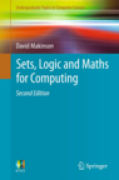
This easy-to-follow textbook introduces the mathematical language, knowledge and problem-solving skills that undergraduates need to study computing. The language is in part qualitative, with concepts such as set, relation, function and recursion/induction; but it is also partly quantitative, with principles ofcounting and finite probability. Entwined with both are the fundamental notions of logic and their use for representation and proof. Features: teaches finite math as a language for thinking, as much as knowledge and skills to be acquired; uses an intuitive approach with a focus on examples for all general concepts; brings out the interplay between the qualitative and the quantitative inall areas covered, particularly in the treatment of recursion and induction; balances carefully the abstract and concrete, principles and proofs, specific facts and general perspectives; includes highlight boxes that raise common queries and clear confusions; provides numerous exercises, with selected solutions. Only minimal background in mathematics necessary. Careful selection of material that is really needed by students in the first two years of their university life in Computer Science and Information Sciences. Brings out the interplay between qualitative thinking and calculation. Teaches the material as a language for thinking in, as much as knowledge to be gained. INDICE: Collecting Things Together: Sets. Comparing Things: Relations. Associating One Item with Another: Functions. Recycling Outputs as Inputs: Induction and Recursion. Counting Things: Combinatorics. Weighing the Odds: Probability. Squirrel Math: Trees. Yea and Nay: Propositional Logic. Something about Everything: Quantificational Logic. Just Supposing: Proof and Consequence.
- ISBN: 978-1-4471-2499-3
- Editorial: Springer London
- Encuadernacion: Rústica
- Páginas: 280
- Fecha Publicación: 31/03/2012
- Nº Volúmenes: 1
- Idioma: Inglés
